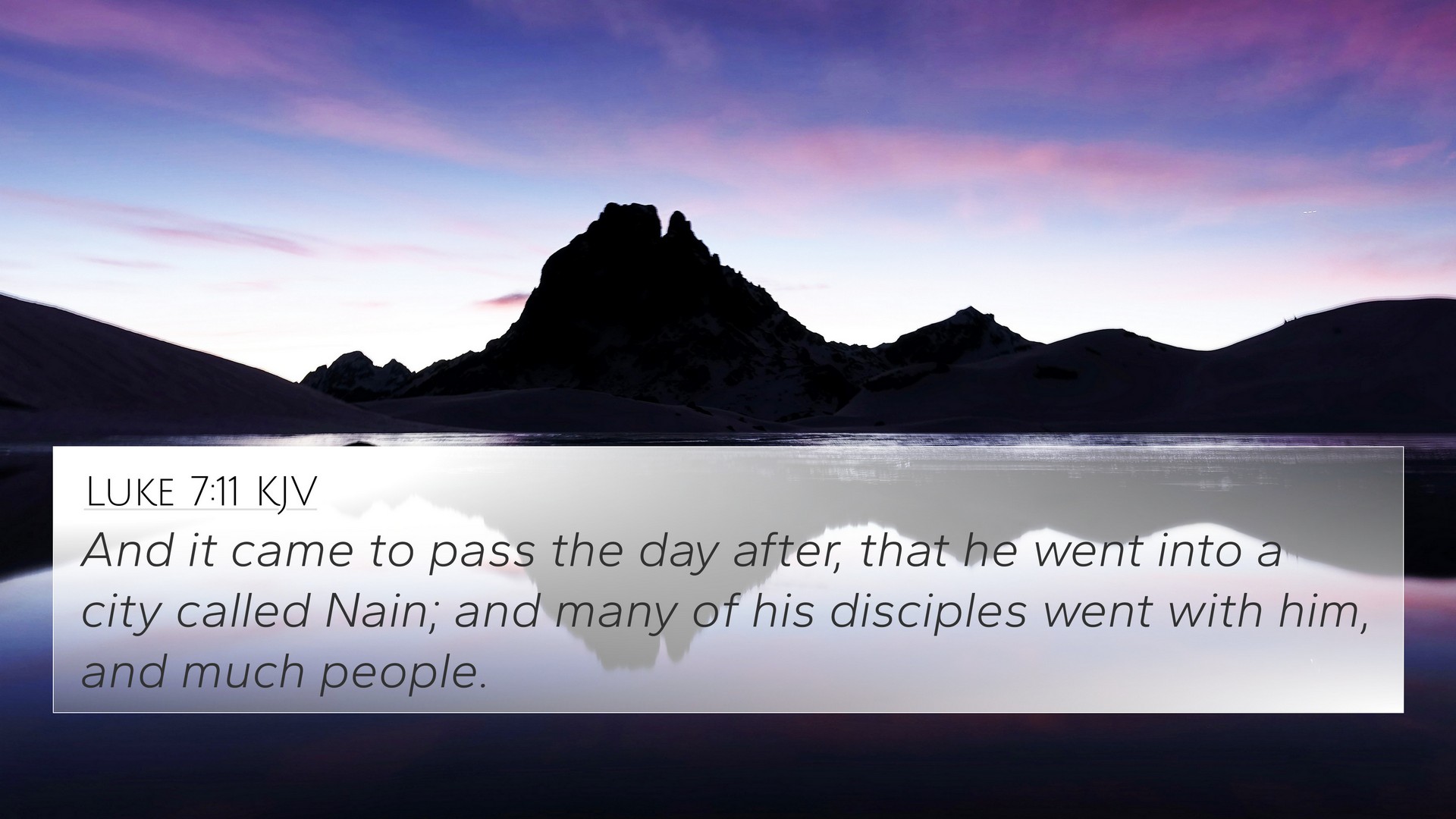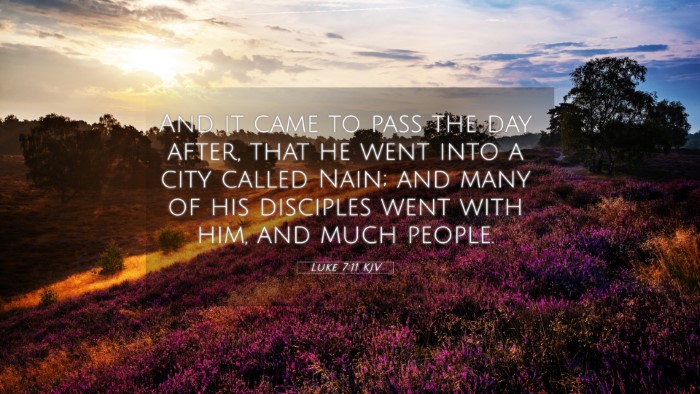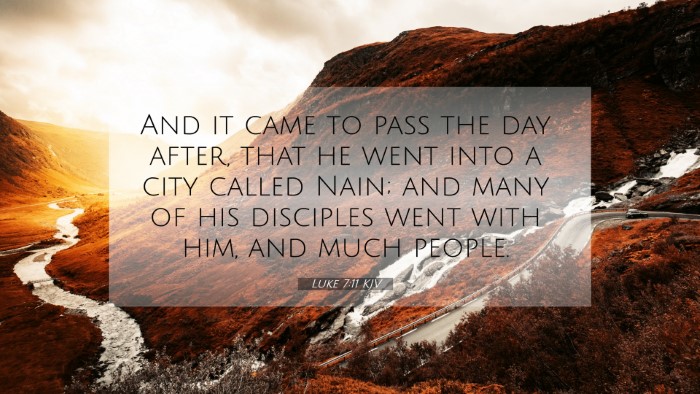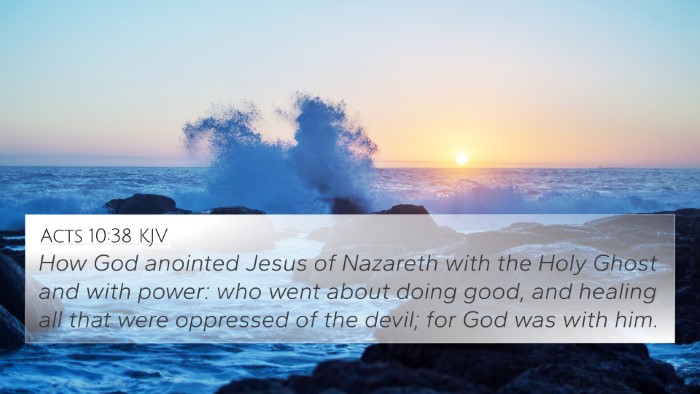Understanding Luke 7:11
Luke 7:11 states, "Soon afterward he went to a town called Nain, and his disciples and a large crowd went along with him." This passage describes an event in the life of Jesus where he encounters a grieving widow at the town of Nain. Below is a summary and interpretation derived from public domain commentaries by Matthew Henry, Albert Barnes, and Adam Clarke, alongside a thematic analysis of related Bible verses.
Context and Analysis
In this verse, we encounter Jesus as He travels with His disciples and a multitude. The significance of this journey is emphasized in the context of what follows—the raising of the widow's son, which highlights Jesus' compassion and miraculous capabilities.
Matthew Henry notes that this event occurs immediately after the healing of a centurion's servant, illustrating the broad reach of Jesus’ ministry. He emphasizes that the crowd following Jesus indicates the growing fame of the Messiah, emphasizing both His popularity and the anticipation of His miracles.
Albert Barnes elaborates on the logistical aspects of Jesus' journey, suggesting that the large following demonstrates the public interest in His mission. He points out that the name "Nain," meaning "beautiful," potentially underscores the beauty of Christ's ministry in restoring life and hope.
Adam Clarke provides insights into the geographical and cultural significance of Nain. He describes it as being near significant locations, suggesting that Jesus chose to travel this route to fulfill prophetic implications and to reach various demographics, including those who were marginalized.
Thematic Connections
The account in Luke 7:11 serves as a powerful narrative that connects various Biblical themes such as compassion, resurrection, and faith. Here are some notable thematic connections:
- Compassion: Jesus' empathy towards the widow can be linked to passages like Matthew 9:36, where Jesus sees the crowds and feels compassion for them.
- Miraculous Acts: The miraculous raising of the widow’s son relates closely to John 11:43-44, where Jesus raises Lazarus, showcasing His power over death.
- Restoration: This event parallels the story of the raising of the daughter of Jairus in Mark 5:41-42, where Jesus restores life to a young girl.
- The Hope of Resurrection: The theme of hope in the resurrection is echoed in 1 Thessalonians 4:14, which assures believers of their own future revival.
- Divine Authority: Jesus’ authority to command life connects with Matthew 28:18, where He proclaims sovereign authority over heaven and earth.
- Faith: The widow's plight invokes faith in divine intervention, similar to the faith shown by the woman with the issue of blood in Mark 5:34.
- Jesus as Savior: Connections can be drawn to 1 John 4:14 where Jesus is recognized as the Savior of the world, resonating with His acts of mercy.
- Communal Influence: The gathering crowd reflects the communal aspect of faith, akin to Acts 2:44-47 where believers were together, sharing in miraculous events.
Cross References
To enhance your understanding of Luke 7:11, consider cross-referencing these related Bible verses:
- Matthew 9:36 - Jesus' compassion for the lost.
- Mark 5:41-42 - The raising of Jairus' daughter.
- John 11:43-44 - The resurrection of Lazarus.
- 1 Thessalonians 4:14 - Resurrection hope.
- Matthew 28:18 - The authority of Jesus.
- Mark 5:34 - Faith in healing.
- 1 John 4:14 - Jesus as the Savior.
- Acts 2:44-47 - Early church practices and miracles.
Conclusion
Luke 7:11 not only provides a profound glimpse into the life of Jesus during His ministry but also opens avenues for cross-referencing Biblical texts for deeper understanding. By examining the connections between scripture, we can enrich our comprehension of divine compassion, human suffering, and the hope of resurrection. This type of Bible cross-reference guide can prove invaluable for personal study, sermon preparation, and fostering a deeper connection with Biblical narratives.



